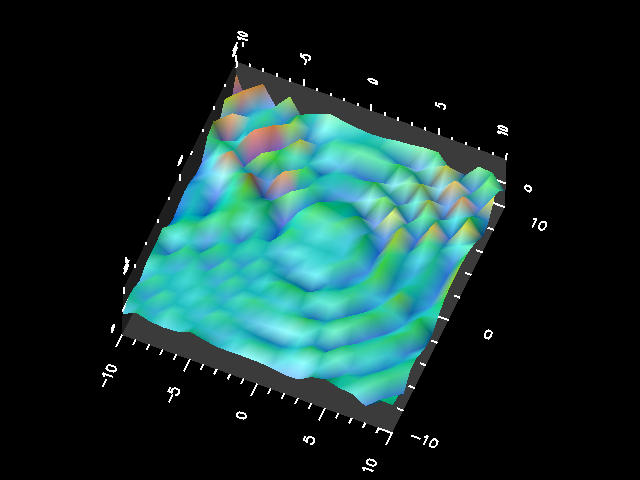
|
Prey Localization through the Lateral-Line System |

|

|
|
|
|
The clawed frog Xenopus is a predator catching prey at night by detecting water movements. We present a general method, a "minimal model" based on a minimum-variance estimator, to explain prey detection through the frog's lateral-line organs. Waveform reconstruction allows Xenopus to determine both direction and character of the prey and even to distinguish two simultaneous wave sources. We have produced a video showing how the water surface is reconstructed by the clawed frog ( MPEG 7.8 MB , Quicktime 13 MB ) . 
There are wave sources on the upper left corner of the displayed water surface and on the upper right corner, with frequencies of 20 Hz (left) and 10 Hz (right). The video plays in slow motion with a speed of 1/10. The clawed frog assumes the wave sources in the directions where the reconstructed oscillation of the water surface has the largest amplitude (displayed in red). The clawed frog can determine the directions of the wave sources (left and right ahead) as well as their frequencies (the source with the higher frequency is on the left). According to another neuronal model (Franosch 2005), the clawed frog can even learn to interpret the information it gets from its lateral-line system. The frog's eyes allow it to see the water surface. Neurons are excited by the image of the moving prey as well as by the moving water at Xenopus' skin. The neurons adapt its connective strengths to the velocity receptors such that after some time the water wave alone is sufficient to excite the neurons. The visual image is no more needed. After the learning process, the neuron that is responsible for one direction is only activated iff the water wave originates from the proper direction. So the activity of the neurons reports the direction where the prey is. References Franosch JMP, Sobotka MC, Elepfandt A and van Hemmen JL. Minimal Model of Prey Localization through the Lateral-Line System. Phys Rev Lett 91:1581011-1581014 (2003) ( PDF 214 KB , PS GZip 234 KB ) Franosch JMP, Elepfandt A and van Hemmen JL. Minimal Model of Prey Localization through the Lateral-Line System , Poster presentation at the Göttinger Neurobiologentagung ( 2003 ) ( PDF 581 KB , PS GZip 1.2 MB , TeX 8 KB ) Good Vibrations Help a Frog Locate Tasty Prey, Physics News Update, number 653, September 12, 2003. Frogs turn to physics, PhysicsWeb, 16 October 2003. Vibrations help a frog locate tasty prey, Physics Today, vol. 56, issue 11, 2003.
Was
geschieht wo auf der Wasseroberfläche?, Short News 2003-11-03,
Physik
Department, TU Munich.
Virtual Journal of Biological Physics Research, vol. 6, issue 8, October 15, 2003.
Beutefang durch Wellenformanalyse, Physik
Journal 11/2003.
Hungrige
Frösche als Rechenkünstler, spektrumdirekt, 17. September
2003.
Franosch JMP, Lingenheil M and van Hemmen JL. How a Frog Can Learn What is Where in the Dark. Phys Rev Lett 95:078106 (2005) ( PDF 148 KB ) African frog hunts with eyes wide shut, New Scientist 2514(2005) ( JPEG 489 KB , PDF 638 KB ) . How a Frog Can Learn What Is Where in the Dark, Virtual Journal of Biological Physics Research Volume 10, Issue 4, August 15, 2005.
Leo van Hemmen, Wie funktioniert unser Gehirn?, Mitteilungen
der Technischen Universität München, 3(2005),
44-45.
last modified 2007-11-05 by webmaster@Franosch.org |





